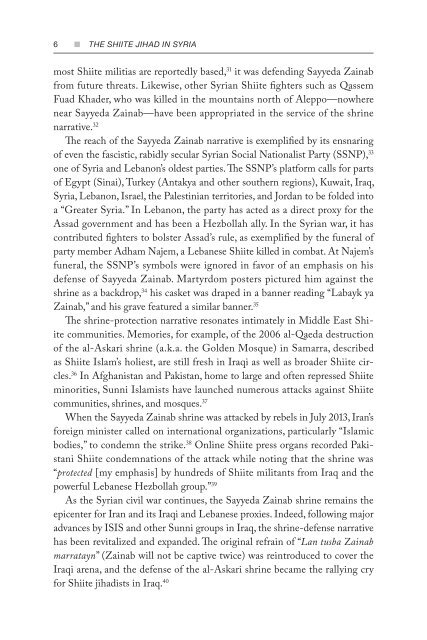You also want an ePaper? Increase the reach of your titles
YUMPU automatically turns print PDFs into web optimized ePapers that Google loves.
6 n <strong>THE</strong> <strong>SHIITE</strong> <strong>JIHAD</strong> <strong>IN</strong> <strong>SYRIA</strong><br />
most Shiite militias are reportedly based, 31 it was defending Sayyeda Zainab<br />
from future threats. Likewise, other Syrian Shiite fighters such as Qassem<br />
Fuad Khader, who was killed in the mountains north of Aleppo—nowhere<br />
near Sayyeda Zainab—have been appropriated in the service of the shrine<br />
narrative. 32<br />
The reach of the Sayyeda Zainab narrative is exemplified by its ensnaring<br />
of even the fascistic, rabidly secular Syrian Social Nationalist Party (SSNP), 33<br />
one of Syria and Lebanon’s oldest parties. The SSNP’s platform calls for parts<br />
of Egypt (Sinai), Turkey (Antakya and other southern regions), Kuwait, Iraq,<br />
Syria, Lebanon, Israel, the Palestinian territories, and Jordan to be folded into<br />
a “Greater Syria.” In Lebanon, the party has acted as a direct proxy for the<br />
Assad government and has been a Hezbollah ally. In the Syrian war, it has<br />
contributed fighters to bolster Assad’s rule, as exemplified by the funeral of<br />
party member Adham Najem, a Lebanese Shiite killed in combat. At Najem’s<br />
funeral, the SSNP’s symbols were ignored in favor of an emphasis on his<br />
defense of Sayyeda Zainab. Martyrdom posters pictured him against the<br />
shrine as a backdrop, 34 his casket was draped in a banner reading “Labayk ya<br />
Zainab,” and his grave featured a similar banner. 35<br />
The shrine-protection narrative resonates intimately in Middle East Shiite<br />
communities. Memories, for example, of the 2006 al-Qaeda destruction<br />
of the al-Askari shrine (a.k.a. the Golden Mosque) in Samarra, described<br />
as Shiite Islam’s holiest, are still fresh in Iraqi as well as broader Shiite circles.<br />
36 In Afghanistan and Pakistan, home to large and often repressed Shiite<br />
minorities, Sunni Islamists have launched numerous attacks against Shiite<br />
communities, shrines, and mosques. 37<br />
When the Sayyeda Zainab shrine was attacked by rebels in July 2013, Iran’s<br />
foreign minister called on international organizations, particularly “Islamic<br />
bodies,” to condemn the strike. 38 Online Shiite press organs recorded Pakistani<br />
Shiite condemnations of the attack while noting that the shrine was<br />
“protected [my emphasis] by hundreds of Shiite militants from Iraq and the<br />
powerful Lebanese Hezbollah group.” 39<br />
As the Syrian civil war continues, the Sayyeda Zainab shrine remains the<br />
epicenter for Iran and its Iraqi and Lebanese proxies. Indeed, following major<br />
advances by ISIS and other Sunni groups in Iraq, the shrine-defense narrative<br />
has been revitalized and expanded. The original refrain of “Lan tusba Zainab<br />
marratayn” (Zainab will not be captive twice) was reintroduced to cover the<br />
Iraqi arena, and the defense of the al-Askari shrine became the rallying cry<br />
for Shiite jihadists in Iraq. 40


